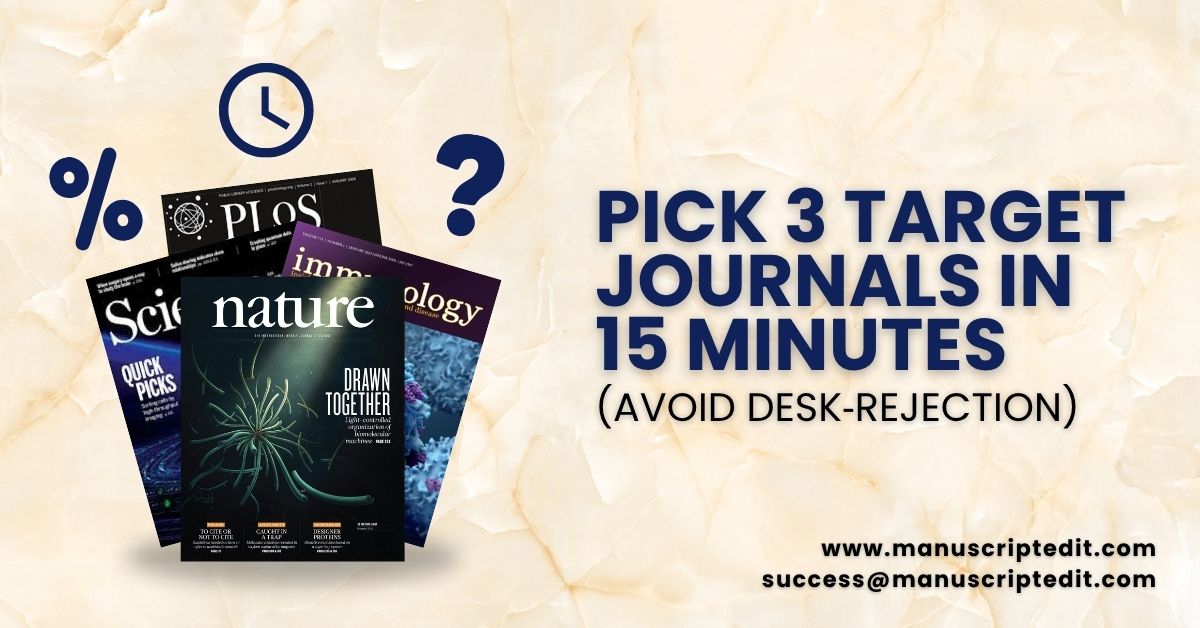Let’s be honest: choosing journals can feel like speed‑dating with gatekeepers. You want a good match, not a fast heartbreak. The goal of this 15‑minute Journal Selection Review (JSR) is simple: walk away with a Primary, a Backup, and a Safety journal—each with a real reason why your paper belongs there. Fifteen minutes won’t replace thoughtful strategy, but it will prevent the classic facepalm: desk rejection for scope or formatting. We’ll do this with a timer, a checklist, and a tiny bit of humour so you actually finish. If time is tighter than your methods section, hand it to ManuscriptEdit and we’ll run the JSR for you (₹8,000; global delivery). Ready? Timer on. Coffee optional, confidence mandatory.
Table of Contents
Step 1 — Define your paper’s ‘About’ in 30 seconds
Write one line: design + population + topic/outcome. Example: “Multicentre cohort; adults with T2DM; predicting 30‑day readmission.” This single sentence steers your aim‑and‑scope search and saves you from journals that love your topic but not your design (or vice versa).
Step 2 — Quick scope scan (4 minutes)
Open Journal A’s Aims & Scope. Do your nouns match theirs? (population, methods, outcome domain) Check article types: do they publish your type (Original, Short Report, Systematic Review, etc.)? If you must bend your abstract to fit, that’s a mismatch—park Journal A as a maybe and move on.
Step 3 — Recent similar papers (4 minutes)
Browse Journal A’s last 12–24 months: can you find 2–3 papers that look like yours in design/topic? If yes, this is a fit signal and ready‑made citation ammo for your cover letter (“builds on/extends/contradicts…”). If no, don’t force it—Editors smell the mismatch before the PDF finishes uploading.
Step 4 — Logistics snapshot (3 minutes)
Open the instructions for authors. Jot down: reference style (Vancouver/APA), word limits, figure limits, data availability, average decision times (if published), open access/APCs, and any red flags (opaque fees, predatory signs). Speed matters, but hidden logistics can hurt more than a week of waiting.
Step 5 — Repeat quickly for Journal B and Journal C (3–4 minutes)
You are looking for a *portfolio*, not a soulmate: a Primary (ambitious but realistic), a Backup (similar prestige/scope), and a Safety (broader or faster). If Journal A is glamour, make sure B and C are steady pros.
The 3‑Journal Shortlist (fill this in as you go)
• Journal A (Primary): Scope fit (why), 2 recent similar papers (links), indexing (Scopus/WoS), decision time, APCs.
• Journal B (Backup): Scope fit (why), 1–2 recent similar papers, indexing, turnaround, APCs.
• Journal C (Safety): Scope fit (why), decision time, APCs, special issue options.
What Actually Happens (because we’ve all been there)
Editor brain: “Lovely study. Wrong audience.” (clicks ‘desk reject’)
Your brain: “But the science is good!”
Reality: Fit comes first. Then science. Then formatting. The order may be unfair—but playing by it wins you a fair review.
How to write two journal‑fit lines (keep these handy)
Line 1: “Our manuscript aligns with your Aims & Scope (X, Y, Z) and addresses [specific audience problem].”
Line 2: “It builds on two recent papers from your journal ([Short Ref 1], [Short Ref 2]) by [contribution].”
Red flags and green lights (fast sanity check)
Green lights: Publishes your article type; recent similar papers; transparent instructions; indexing in Scopus/Web of Science; reasonable decision times; clear ethics/data policies. Red flags: Scope mismatch; “pay then maybe review” vibes; no clear instructions; suspicious indexing claims; impossible word limits for your design.
Why JSR + a mini peer review saves weeks
Journal fit stops preventable desk rejections; mini peer review catches clarity/reporting issues before a human editor does. Together they compress the back‑and‑forth and make your submission look ‘ready to review’—which is the fastest way to yes.


Your 15‑minute action plan (pin this)
1) Write one “About” line (design + population + topic).
2) Scope‑scan Journal A; find 2 similar papers; note logistics.
3) Repeat for Journals B and C.
4) Draft two cover‑letter fit lines.
5) Pick Primary/Backup/Safety and set a submission date. Journal choice shouldn’t feel like roulette.
With a 15‑minute JSR you’ll know where your paper belongs, how to argue the fit, and what logistics to prep so your submission looks professional on day one. That calm confidence is what turns great data into a fast, fair review.
Click Here to read more such interesting blogs.




